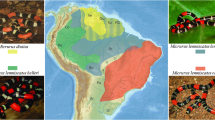Abstract
Palytoxin, a highly toxic natural product isolated from zoanthids of the genus Palythoa, is accumulated by a wide range of fishes and marine invertebrates used as food in the Indo-Pacific. It is responsible for many incidents of human morbidity and mortality. The toxin is a potent smooth muscle spasmogen. The cause of the contraction of smooth muscle is unclear, but recent work strongly suggests that it is primarily initiated by the release of neurotransmitters from the motor innervation of the smooth muscle. We show here that palytoxin caused the swelling of the muscle cells and some internal organelles of the anococcygeus muscle of the rat, but no substantial structural damage to the tissue. Axons and Schwann cells were also swollen but the most dramatic feature was the depletion of synaptic vesicles from putative release sites in the axons. Some axons were physically damaged following exposure to the toxin, but this was relatively uncommon (<10% of all axons studied). In the majority of axons there was no damage to nerve terminal membranes, but there was damage to mitochondria. The depletion of vesicles involved all types – clear, dense-cored, large and small. Our observations and pharmacological data gathered elsewhere, provide a neuropathological basis for the spasmogenic activity of palytoxin.
Similar content being viewed by others
References
Alcala, A. C., Alcala, L. C., Garath, J. S., Yasumara, D. & Yasumoto, T. (1988) Human fatality due to ingestion of the crab Demania reynaudii that contained a palytoxin-like toxin. Toxicon 26, 105–7.
Attaway, D. H. & Ciereszko, L. S. (1974) Isolation and partial characterization of Caribbean palytoxin. In Proceedings of the Second International Coral Reef Symposium, Vol. 1 (edited by The Great Barrier Reef Committee) pp. 497–504. Brisbane, Australia: The Great Barrier Reef Committee.
Axelsson, S., Bjorklund, A., Falk, B., Lindvall, O. & Svensson, L. A. (1973) Glyoxylic acid condensation: a new fluorescence method for the histochemical demonstration of biogenic monoamines. Acta Physiologica Scandinavica 87, 57–62.
Burnstock, G. (1970) The structure of smooth muscle and its innervation. In Smooth muscle (edited by Bulbring, E., Brading, A. F., Jones, A. W. & Tomita, T.) pp. 1–69. London: Edward Arnold
Cottee, L. J., Varidis, N. A. Bennett, M. R. (1996) Spatial relationships between sympathetic varicosities and smooth muscle cells in the longitudinal layer of the mouse vas deferens. Journal of Neurocytology 25, 413–25.
Dubois, J. M. & Cohen, J. B. (1977) Effect of palytoxin on membrane potential and current of frog myelinated fibres. Journal of Pharmacology and Experimental Therapeutics 201, 148–55.
Gabella, G. (1995) The structural relations between nerve fibres and muscle cells in the urinary bladder of the rat. Journal of Neurocytology 24, 159–87.
Gibbins, I. L. & Haller, C. J. (1979) Ultrastructural identification of non-adrenergic, non-cholinergic nerves in the rat anococcygeus muscle. Cell and Tissue Research 200, 257–271.
Gillespie, J. S. (1972) The rat anococcygeus muscle and its response to nerve stimulation and to some drugs. British Journal of Pharmacology 45, 404–16.
Gillespie, J. S. & LÜllman-Rauch, R. (1974) On the ultrastructure of the rat anococcygeus muscle. Cell and Tissue Research 149, 91–104.
Gonzales, R. B. & Alcala, A. C. (1977) Fatalities from crab poisoning on Negros Island, Philippines. Toxicon 15, 169–70.
Habermann, E. (1989) Review Article: Palytoxin acts through Na+-K+ ATPase. Toxicon 27, 1171–81.
Hashimoto, Y., Fusetani, N. Kimura, S. (1969) Aluterin: A toxin of file fish, Alutera scripta, probably originating from a zoantharian, Palythoa tuberculosa. Bulletin of the Japanese Society of Fisheries 35, 1086–93.
Hirata, Y., Uemura, D., Ueda, K. & Takano, S. (1979) Several compounds from Palythoa tuberculosa. Pure and Applied Chemistry 51, 1875–83.
Kudo, Y. & Shibata, S. (1980) The potent depolarizing action of palytoxin isolated from Palythoa tuberculosa on the isolated spinal cord of the frog. British Journal of Pharmacology 71, 575–9.
Moore, R. E. & Scheuer, P. J. (1971) Palytoxin: a new toxin from a coelenterate. Science 172, 495–8.
Noguchi, T., Hwang, D.-F., Arakawa, O., Daigo, K.,Sato, S., Ozaki, H., Kawai, N., Ito, M. & Hashimoto, K. (1987) Palytoxin as the causative agent in parrot fish poisoning. In Progress in Venom and Toxin Research (edited by Gopalakrishnakone, P. & Tan, C. K.) pp. 325–335. Singapore: Kent Ridge.
Ozaki, H., Tomono, J., Nagasi, H. & urakawa, N. (1983) The mechanism of contractile action of palytoxin on vascular smooth muscle of guinea-pig aorta. Japanese Journal of Pharmacology 33, 1155–62.
Pichon, Y. (1982) Effects of palytoxin on sodium and potassium permeabilities in unmyelinated axons. Toxicon 20, 41–47.
Posangi, J., Zar, M. A. & Harris, J. B. (1992) The action of palytoxin on the isolated detrusor muscle of the rat. British Journal of Pharmacology 106, 307–14.
Posangi, J., Harris, J. B. & Zar, M. A. (1994) Palytoxin-induced transmitter release in the autonomic nervous system of the rat. Toxicon 32, 965–975.
Rouzaire-Dubois, B. & Dubois, J.-M. (1990) Characterization of palytoxin induced channels in mouse neuroblastoma cells. Toxicon 28, 1147–58.
Shimahara, T. & Molgo, J. (1990) Palytoxin enhances quantal acetylcholine release from motor nerve terminals and increases cytoplasmic calcium levels in a neuronal hybrid cell line. Pharmacology (Life Science Advances) 9, 785–92.
Tesseraux, I., Harris, J. B. & Watkins, S. (1983) Physiological and morphological effects of palytoxin (Palythoa caribaeorum) on skeletal muscle. In Toxins as a Tool in Neurochemistry (edited by Hucho, F. & Ovchinnikov, Y. A.) pp. 91–100. Berlin: Walter de Gruyter.
Thaemert, J. C. (1966) Ultrastructural interrelationships of nerve processes and smooth muscle cells in three dimensions. Journal of Cell Biology 28, 37–49.
Tranzer, J. P. & Richards, J. G. (1976) Ultrastructural cytochemistry of biogenic amines in nervous tissue: methodologic improvements. Journal of Histochemistry and Cytochemistry 24, 1178–93.
Author information
Authors and Affiliations
Rights and permissions
About this article
Cite this article
Amir, I., Harris, J.B. & Zar, M.A. The effect of palytoxin on neuromuscular junctions in the anococcygeus muscle of the rat. J Neurocytol 26, 367–376 (1997). https://doi.org/10.1023/A:1018512920100
Issue Date:
DOI: https://doi.org/10.1023/A:1018512920100




